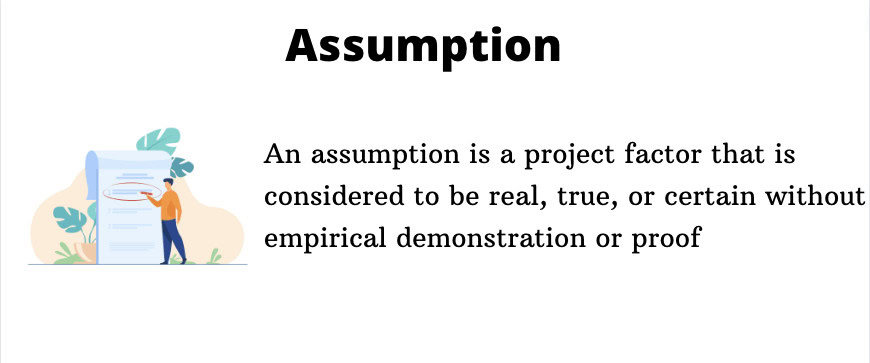
A project assumption is a factor or condition that is accepted as true, real, or certain without requiring empirical validation or concrete proof. In practice, project planning cannot proceed without making certain assumptions about future conditions, resource availability, and project parameters. The primary objective is to systematically identify these assumptions and establish appropriate contingency measures to minimize potential project impact should any assumptions prove inaccurate.
Understanding what project assumptions are is just the first step in effective project management. The real challenge lies in recognizing why these assumptions matter so much to project success. When assumptions go unidentified or unmanaged, they can silently undermine even the most well-planned projects, leading to budget overruns, missed deadlines, and unmet objectives. This is why the systematic identification and management of assumptions becomes a critical competency for project managers.
Importance Of Identifying Assumptions
The systematic identification of assumptions and risks enables project managers to evaluate proposed activities and objectives, determining their feasibility within established timeframes and available financial and human resources. Assumptions play a crucial role in developing comprehensive risk management strategies. As a project manager, you must proactively identify and manage the broadest range of assumptions possible to maximize the probability of successful project completion within budget and schedule constraints.
Engage your project team throughout the assumption identification process. Document all assumptions clearly and comprehensively to ensure team members can effectively understand and manage them. Upon compiling your project assumptions inventory, share it with key stakeholders for review and validation. Continuously monitor and validate assumptions throughout the project lifecycle, making necessary adjustments as circumstances evolve.

Who Is Responsible For Preparing And Maintaining The Assumptions Log?
An assumption log is required during the project lifecycle to develop an understanding of what assumptions have been considered during the planning and management of the project. Assumptions are the key information based on which project decisions and plans are made. The project manager is responsible for preparing and maintaining assumption logs.
The project manager creates the assumptions log during the project initiation phase while he creates the business case and uses the content for the project charter. Higher-level assumptions are used by the manager at this stage. The assumptions log is reviewed and maintained throughout the project lifecycle, and lower-level assumptions based on products and tasks are also created.
As a project manager, you must manage project assumptions skillfully as they are a series of moving parts in the project and can affect the project’s success. You can make assumptions based on similar past projects and monitor them as potential risks. Where you find inaccuracies in the assumptions log, you must identify and correct them quickly and be sure to communicate and document the changes to stakeholders.

Types Of Assumptions
The project managers commonly make the following project assumptions:
- Schedule Assumptions: Schedule assumptions are also called time-based assumptions, and they relate to the project timeline. They may change when the timeline of the project is changed. Some examples of schedule assumptions are specifying the durations, tasks, and dependencies to complete the project.
- Technology Assumptions: Technology assumptions can influence the type of technology used for the project. It’s important to develop contingency plans to manage technology. Some examples of technology assumptions are specifying the platforms, software, and infrastructures to be used for a project.
- Resource Assumptions: Project managers use these assumptions to allocate resources, including workers, funding, and materials. It is a major part of project management and can affect the resources available to the project team. Resource assumptions include material, people, and facilities for the project.
- Cost Assumptions: Cost assumptions are the projections made by the project managers regarding project cost. These assumptions can have an impact on the project budget and the whole project. Project managers must handle these assumptions by complying with cost management procedures and updating the budget.
- Quality Assumptions: Quality assumptions include quality standards. They are important as the project duration can change depending on whether the project meets standards.

Difference Between Assumption and Constraint
Assumptions are built into the project plan and are believed to be true. Constraints, on the other hand, are those things that are known to be true and must be accounted for in the plan so that they can be worked around. Also, constraints are a factor that limits the options of the team’s schedule, resources, and time. Assumptions are typically riskier as they are uncertain.
Project managers must invest their time in managing the risks of assumptions. Constraints are less risky as they are already known. As a project manager, you must identify and document assumptions and constraints. Understanding assumptions and constraints, and the difference between assumptions and constraints, is important to make the project successful.

Difference Between Assumptions and Dependencies
Assumptions are conditions or events that are perceived to be true. They are stated without any evidence or proof. A project manager must make specific assumptions to continue any project, as there are always factors that are beyond control. Assumptions do not have any support from facts. They are based on the experience and knowledge of the project stakeholders and the available project information.
They have to be managed and documented throughout the project. On the other hand, dependencies exist between activities and are represented as a directional relationship. The activities are called successor and predecessor. They are separated by an arrow that signifies the direction of the dependency.

The diagram above represents a project schedule and a finish-to-start relationship, one of the four possible relationships between activities. The common relationship is the finish-to-start relationship in which the start of a successor activity is dependent on the finish of its predecessor activity.
Your project can have external dependencies, such as activities that your vendor or client is responsible for. It is important to take all activities in a project into account, whether they are external or internal.
Examples Of Project Assumptions
Let’s have a close look at the assumptions that have an impact on the project. They can fall under a few categories, including budget assumptions, resource assumptions, and scope assumptions.
Some specific examples of project assumptions are as below:
- The project manager will have access to both material and human resources to complete the project.
- Project team members will have all the resources needed to complete tasks, including software, electricity, and specialized equipment.
- Costs of personnel will remain the same throughout the project.
- Other resources and material costs will remain the same throughout the project.
- The total costs of daily operations will remain the same.
- The equipment will be provided in working condition.
What are Assumptions Examples?
- Resources: End users will maintain availability throughout the testing phase. Qualified trainers will remain accessible during all training sessions.
- Delivery: Project servers will arrive pre-configured and ready for deployment. Hardware devices will be delivered on schedule without delays.
- Budget: Project costs and budget allocations will remain stable throughout the project lifecycle. Training will be conducted internally, eliminating additional external training expenses.
- Finances: Departmental budgets will provide necessary license funding as planned.
- Scope: Project scope will remain fixed with no scope creep. The project scope will not be modified following stakeholder approval of the project charter.
What is an Assumption Log in Project Management?
An assumption log is a comprehensive document employed by project teams and project managers to systematically track, record, and document project assumptions. These assumptions constitute critical information that forms the foundation for project decision-making and strategic planning processes. All assumptions require thorough validation and ongoing monitoring to assess their potential impact on project outcomes.
The assumption log, initially developed during the project initiation phase, becomes an integral component of the project charter. During initiation, high-level strategic assumptions are documented, while more detailed operational assumptions are captured and maintained throughout the entire project lifecycle.
Suggested articles:
- Risk Transference in Project Management
- Optimistic Time In Project Management
- Secret Strategy to Define Activities in Project Management
Shane Drumm, holding certifications in PMP®, PMI-ACP®, CSM, and LPM, is the author behind numerous articles featured here. Hailing from County Cork, Ireland, his expertise lies in implementing Agile methodologies with geographically dispersed teams for software development projects. In his leisure, he dedicates time to web development and Ironman triathlon training. Find out more about Shane on shanedrumm.com and please reach out and connect with Shane on LinkedIn.